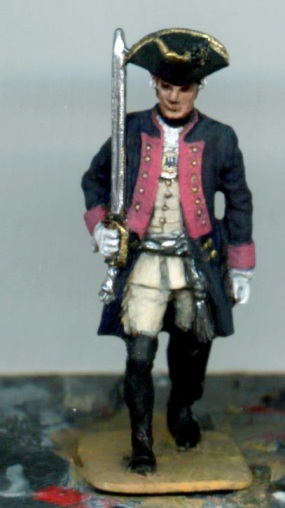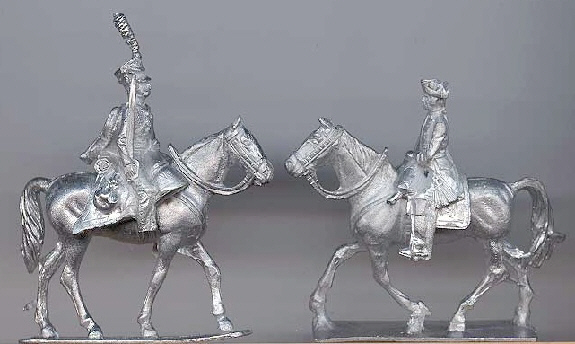|
|
|||||||||||||||||
 |
|||||||||||||||||
 |
|||||
|
Originally Published on the Spanner and the Yank Web Site. Used by permission. |
|||||
|
March 6, 2002 The 30 mm Investigations One of the perks in reviewing figs (and being a bona fide Internet ‘ranter’) is there’s no obligation to be consistent. In the past few months Dal and I decided to date articles, in order to chronicle our own changes of opinion. Case in point: I’ve previously stated 20 mm is the ideal figure size, as it’s the best compromise between the demands of containing a wargame within a manageable playing area, and at the same time, creating visual impact. Well, there’s been a change of heart. As much as I’d like to see some semblance of standardization in historical gaming, I believe 10 mm is more suitable for battle simulations. The latter looks comparatively ‘real’ and yields considerably more space for maneuver. Those drawn to the hobby by the visual enjoyment of miniatures, however, should plug into 28-30mm’s. (Note 1) Why? As much as I love AB’s, I’m not sure anyone can appreciate Tony Barton’s excellent detail without magnification. They’re a joy to paint, but it’s easy to lose sight of the end purpose. All your meticulous painting is hard to discern from two feet away. And if that is the case, there’s little point to their being 18 mm high. The truth is The Holy Grail of "realistic" battle simulation will remain… The Holy Grail. It cannot be accomplished, unless you’re gaming in an airplane hanger. That doesn’t mean the puzzle isn’t fun in itself (i.e., how do you place 60,000 men on a table in the den?). But to know the limitations is to relax and enjoy the hobby’s incongruities. Rules designers unwittingly sapped much of the play out of pure fantasy and illusion. And many of us are beating a path back to the writings of Charles Grant (Ain't we! Dal)…. Because the rules I tried never ‘looked right’, I failed to buy into any set of rules, and became hung up more on the visual display of grouped miniatures. The gnomish appearance of contemporary 25-28 mm’s turned me off to the larger scales. Only recently have I begun looking at now dated and harder-to-find 30’s, created in the late 1960s and early ‘70’s (’see Suren "Willies" review). Tradition 30’s (a.k.a. Tradition Scandinavia’s, a.k.a. Stadden’s) In my recent "Willie" review, I noted the sculpting was hit-and-miss crude (if imaginative) and the horses were decidedly two-dimensional. Ed Studer, a US distributor for both Willie’s and Tradition 30’s, suggested I try the latter. He said the horses were better, and overall, the figures were cleaner. The two ranges could "be mixed" (confirmed). I recall Stadden 54 mm figures from high school days. They were the first and only miniatures I painted until the 1990’s. Charles Stadden was the designer, and at some point in the ensuing years, he created the 30mm’s for gaming. I don’t have the details on who-sold-what-to-whom (it’s enough of a headache trying to keep up with major corporate M&A’s). But the gist of it is Stadden figures became Tradition figures; and the 30’s were (still are) manufactured in Sweden. The Figs I ordered some SYW Prussian and Napster samples from Tradition USA. (The range is very limited and will only be of interest to those who can do conversions.) The group included a French Napoleonic hussar, Prussian musketeers, a mounted Prussian officer and a British Nap. Line infantryman. I was disappointed with the casting quality as one figure arrived without a right foot and another had only a portion of his nose. (At the time of this article, I’m not sure whether the distributor imports these or casts them himself.) They’re cleaner, however, than the ‘Willie’s". And the overall composition is nice. The limitations of laying them on a scanner bed doesn’t do them justice. (Note: The smaller ranges lay flat.)
Anatomically, either Traditions or Willie’s are well proportioned. The Traditions are ‘stiff’ when compared to the latter… a sculpting limitation noted with the larger 54 mm Traditions. Suren appears to have been the better sculptor of the two. Willies have a sense of movement and life. But Stadden was more disciplined. And the Tradition line will save you SOME grief in cleaning and repair. As mentioned, some converting will be needed -- not only to provide a suitable number of options -- but also to remedy errors in uniform research. An example is the Prussian under-officer. The figure had no gorget, an infantryman’s pompom, and a tricorn closer in shape to that worn by British officers during the American Revolution. (BTW: What’s with the "American War for Independence"? "Revolution" has been PC’d! too. A tad too radical, I suppose. It’s somewhat like a statue that’s been commissioned in Provo, Utah, depicting (if my memory serves) Jefferson, Franklin and J. Adams kneeling in prayer for divine inspiration. No one particularly cares that the three were deists. Historical fantasy on another scale!) In any event, modifications are in order. The fig below has been reworked with the needed accouterments added and subtracted.
Limitations On the tabletop, with work, these are some of the best gaming figures you can presently obtain. And price wise, they’re competitive, costing just a few pennies more than what you’d pay for a Foundry gnome… and they’re pewter (for those of us who care). However, they’re not for most people. You must be tolerant of multiple shortcomings. (1) The range is limited and whimsical. They were designed as collector pieces first, with wargaming as a developing afterthought. (2) The lack of detail will bother those not prepared to add their own, or leave them ‘as is’. (3) The errors in uniform detail is a true pain. (4) The horses are passable, but I’m reworking both legs and head. The are two different avenues to take: (1) Collect them, creating greater demand for the line. This should (hopefully) result in molds and casting quality receiving more attention (Where there’s money, there’s competition.) Or (2) Lobby manufacturers to produce a range of figures using Traditions and Willie’s as models of what’s desired… minus the cited limitations. Again, as I said in the Willie review, the heavy-lifting has already been done for designers. What’s needed is refinement.
Summation On the table, these truly can look outstanding. Given the present shortcomings, I find it hard to commit to collecting them, however. But the door will be left open on that option. Nothing I’m aware of packs the same visual punch as these figs, particularly some of their American Revolutionary figs, which I purchased in the early ‘90’s from a now defunct distributor. For you creative types, a catalogue can be obtained from the address below for $1.00. Good Gaming, Mike Contact Information: Ed & Miriam Studer Phone/Fax: (952) 890-1634 Note 1: 3/10/02: DON'T LISTEN TO ME! I RECANT! and consistency is back! For the past 14 months, I've been thinking more like a painter than gamer, and acting like a Mormon American Princess (a.k.a. MAP's) on a buying spree in Nordstrom's. The increased reviewing of multiple lines impaired my judgment. Forget what I said about 20's in the Tradition review. And let me restate my current preferences: (1) 20 mm is the ideal figure scale for anyone with the luxury of starting from scratch. It's the best trade-off between gaming and the visual impact of well-painted figs. The problem is that there are no current lines, I'm aware of, that I'd recommend for 18th C., or Napoleonic gaming. (2) 10 mm figures offer the most realistic, overall effect on a wargaming board, and I can recommend GHQ's (if you don't mind sporadic blindness). They're also excellent for those of you who've determined brush work will never be on your resume. (3) 30 mm’s are for fiddlers, painters, and conversion whackos like myself. They can be very impressive. But they'll bankrupt you, and you better have the mentioned airplane hanger to game in. Is there room for all three? Of course, from a collecting standpoint. But if you're building an army?.... no. My advice is to make a determination on the best scale for you, and then put blinders on. My most productive period was c. 1996-99, when I only painted AB's. If you're constantly rummaging through the web sites for something new, you'll end up building little, which has been the case with me for the greater part of 2000-01. Dal and I are back in sync. We need good 20's. Not 15's, or 18's. 20's. And 28's hold no real advantage over the latter. If you paint well, it can be seen. The 2 mm makes a substantial difference. (For those of you collecting ancients, I like Qualiticast. For those of you into W.W.II, AB's are super.) Your Lead Counselor, Mike |
|||||
 |
|||
|
|
|||


